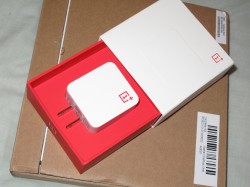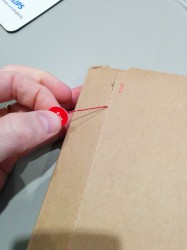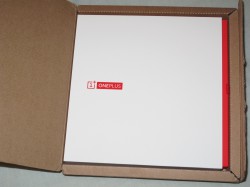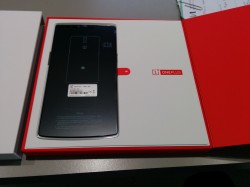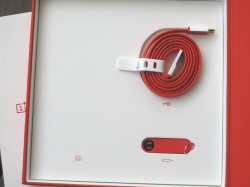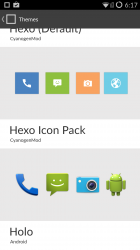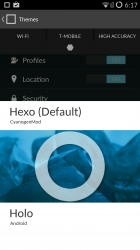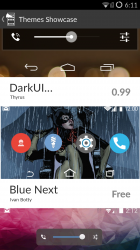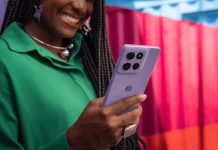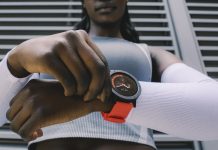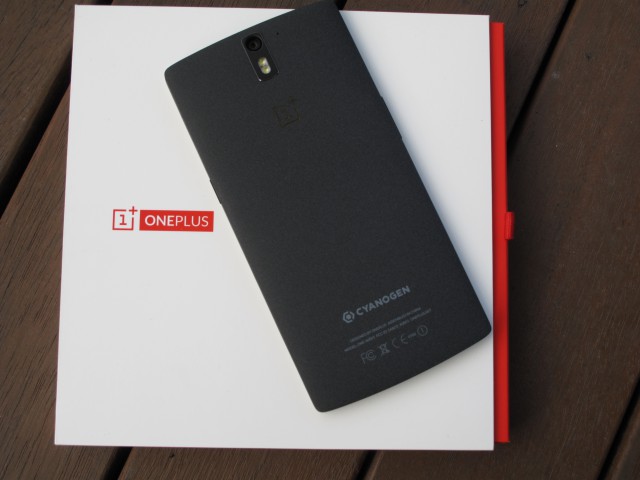
Through persistence, a lot of luck, and a smidgen of skill I managed to secure myself an invite to purchase a 64GB OnePlus One. I immediately took up this offer although at that stage I was informed that it would not be shipping for a few days until a software issue was resolved (turns out the issue was the same bug fix Google performed in 4.4.4 – an OpenSSL vulnerability).
To purchase the phone I had to put in my delivery address as my Comgateway USA address. Five days later it shipped out express from Hong Kong to the US. A few days later it arrived at Comgateway and from there I chose the express option to ship it to me. Within 3 days I had it in my hands. That was Friday. Seems like a lot of hoops to jump through just to purchase a phone. Read on below about my first impressions of it in the first 24 hours and see if I thought it was all worthwhile.
Packaging
Not sure how relevant packaging is to you, the reader, but it ultimately is your first impression of a new device so I thought it worth a mention. The first impression of the OnePlus One packaging was one of disappointment. It looks like a plain brown box. Nothing fancy. The box the US charger was in was separate to the phone box. The charger was in a nicely presented box in the OnePlus red and white colours. After a bit of research it appears the Oppo Find 7 comes in basically the same plain brown box. Put the rip cord on the brown box reveals a beautifully crafted, slim white box with an inner red box sticking out slightly. Inside the box the thought and detail put into the appearance of the OnePlus One and it’s first impressions are immediately apparent. Pull out the tray holding the OnePlus One shows even more detail with the sim tray removal tool and the USB cable.
Overall I was very impressed with the packaging, definitely the nicest packaging I have seen around a phone before. To do all this with the price OnePlus are asking is an incredible feat.
The Display
The LCD screen is a 5.5in JDL LCD with a pixel ratio of 1920 x 1080 (401ppi pixel density). My first impression of the screen was one of disappointment. Coming from a Nexus 5 where I have installed a custom kernel along with LCD colour adjustment to make the colours seem cooler the screen on the OnePlus One looks yellow. After asking around and reading OnePlus forums it seems this was a deliberate decision on behalf of OnePlus. François Simond, aka Supercurio now of the Cyanogen, Inc. team, explained it to me on Google+:
if your device +OnePlus One display white contains more red than your other displays, that’s expected as every other device measured contain too much green and blue, sometimes immensely.
Instead, when following color standards, white is warmer and every color tend to fall into place as well (provided you also provide adequate gamma response curve). Currently most other manufacturer try to mask this initial calibration error by adding color processing (boosting them with various results), but it’s not necessary. After all it makes sense as content producers use displays calibrated to the same standard.
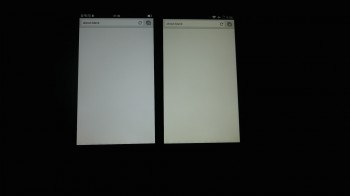 |
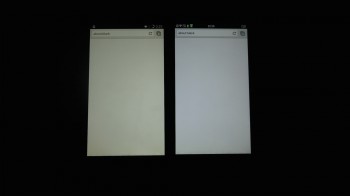 |
Once I was able to get past warmer colours I found the screen to be sharp, crisp and with amazing viewing angles. I could nearly view it from horizontal without any washing out of the screen. The colours popped although as I said above the yellowness of the screen is taking some getting used to. Cyanogen Inc. have gone for true colour representation rather than the over saturation that some other manufacturers prefer.
Camera
I have yet to use the camera extensively but the new camera app is a nice redesign, making it easy to switch from one protocol to another, a simple swipe of the screen switches the app from auto mode to HDR. You can also assign button action to the camera. The power button can be set as the shutter button and the volume buttons as zoom buttons.
So far the camera seems adequate and better than that of the Nexus 5 but a lot more testing is required before I can make a proper judgement of it.
Design
If you are reading this you have seen the OnePlus One so many times over. The phone was trumpeted by OnePlus to be the best looking phone on the market. Not sure about that but it is definitely not ugly. There is nothing revolutionary about the design but it’s beauty is in it’s simplicity.
The front of the phone is different. it has a silver (plastic but doesn’t feel plastic) border around the screen and at the top and bottom of the phone the border is a bit bigger, giving it the feel of the screen sitting on top of a steel plate.
The back is a smooth, almost slippery “sandstone black” with a very subtle, stylish and elegant Oneplus logo beneath the camera and the new Cyanogen, Inc. logo at the bottom. The back is curved so that it fits into the hand holding it well, making it seem not as big as what it is. In saying that, quite a bit of hand gymnastics are still required to navigate the entire screen. It will be interesting to see if my hands get tired using it for long periods or whether my hands will become used to the movements required to navigate a large screen device.
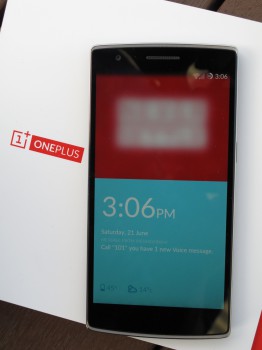 |
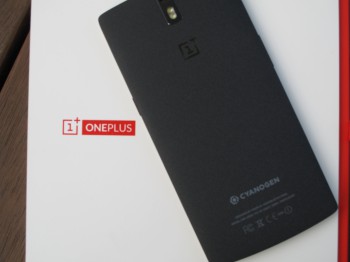 |
Performance
Under the hood is a 2.5GHz Snapdragon 801(MSM8974AC), same as some other 2014 flagships. The difference here is that the OnePlus One does not have to also push an over bearing skin as well as a boatload of useless gimmicks under the hood. It has a relatively unskinned version of Android, although you can theme it easily if you wish. The OnePlus One does not miss a beat and skips from one portion of the OS to another without a moments hesitation. Games play well without any issues. I have tested it out on Sega Sonic Racing and Asphalt 8 and even though I failed miserably at them, the phone was steady and didn’t stutter at all. My ineptness at them is due to my slowing reflexes in my aging body and not the phone not keeping up with the demand.
Think of the speed of a Nexus device when it is new. This is that, easily.
Software
I could write an entire article on the software on this device, but won’t. Yet. It is CyanogenMod (CM), after being trained by Steve Danks. It has all the basic features of CM plus a few extras thrown in, which is why it gets the S designation in version number. It is version CM11S.
As well as the usual tweaks that apply to CM you also get the new theme engine, which considering root access is not required is simply amazing. The amount of things and icons in the OS that can be changed is staggering, and when an icon pack is applied it applied it to the entire OS, not just the launcher or a single app, much the way Unicon does as an Xposed module.
The software is fluid, well presented, and shows how an Android theme should be. Minimal, subtle, and understated. The default CM theme is Hexo and it seems they have done an amazing job implementing it without going overboard. The default CM icon pack was not one of my favourites but a quick trip to the Play Store had that changed quick-smart.
Hardware
We all know about the specs under the hood so I won’t go over them. The phone, although having a plastic housing, feels solid in the hand and definitely not cheap. What intrigued me when I was anticipating getting this phone was the decision I would come to regarding the choice of soft buttons or capacitive buttons. For now I am using the capacitive buttons as I am not a fan of Google/AOSP/CM’s incarnation of the navigation bar. I don’t like how high it is and I don’t like how with CM the only other buttons I can add to the bar are a menu and a search button. I want a power button and I want to assign long press actions to each of them. Not possible with CM at the moment. While it offends my sense of Android purity using capacitive buttons I can see why the Chinese prefer capacitive buttons to the onscreen variety (which is why they were included). They are easy to use and you still have the whole 5.5in screen to enjoy.
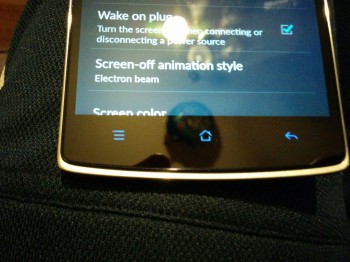
Another difference to pure Android is having the back button on the right and not the left of the home button. After using it for a day I hypothesise that it is on the right because the majority of users are right handed and the back button is used the most of all buttons. Having it on the right means a lot less hand gymnastics to reach the back button and thus faster navigation of the phone.
There is also multi-coloured (RGB) LED light at the top to the left of the speaker grill which can be controlled without root access from within the display settings. Each app that has a notification can be added to the list and any colour you want can be assigned to it. Every manufacturer should include an RGB LED for notifications.
All in all, my first impressions of the phone is that it is an amazing piece of kit and considering it was only $441AU from OnePlus to my door (using the most expensive shipping option each time), it promises to be amazing value for money. My next step will be to play around with all the theming options more and to push the phone and see what it’s limits are.
Are you interested in purchasing a OnePlus One? Have you wavered in your desire for one since it’s first inception?



